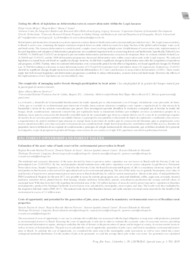Estimation of the asset value of lands reserved for environmental preservation in Brazil.
Estimation of the asset value of lands reserved for environmental preservation in Brazil.
Autoria: FERREIRA, R. R. M.; SOUZA, D. T. de; CASTRO, G. S. A.; MIRANDA, E. E. de
Resumo: The territorial and economic dimension of the areas devoted by farms to preserve native vegetation was not known in Brazil until the Forestry Code was promulgated (Law 12,651/2012). By law, rural properties should maintain areas with native vegetation cover in various categories (Legal Reserve, Permanent Preservation Areas, Surplus Vegetation, etc.). Created by the Forestry Code, the Rural Environmental Registry (CAR) is a mandatory electronic registry for all rural producers that became a relevant tool for agricultural and socio-environmental planning. The aim of this study was to quantify the property asset value of each hectare of legal reserve and permanent preservation areas in Brazil should they be sold for current market prices. Based on the price of land published by FNP Consultoria & Negócio for the year 2017, it is possible to assess by activity group (grain, rice, semi-arid shrubland, coffee, sugar cane, savannah, Amazon rainforest, transition forest, planted forests, fruit farming, Atlantic rainforest, horticulture, pasture, miscellaneous production) the average and full values of municipal land. With data from the CAR regarding the territorial area of the 218 million hectares of areas devoted to preserving native vegetation in Brazilian rural properties, produced by Embrapa Territorial, reserved areas were calculated by municipality, micro-region, and state. The results were then multiplied by the respective full land values (FNP, 2017). The national total shows that Brazilian farmers and cattle ranchers own land assets reserved for the benefit of the environment in excess of 3.1 trillion reais.
Ano de publicação: 2019
Tipo de publicação: Resumo em anais e proceedings
Unidade: Embrapa Territorial
Palavras-chave: Preserve native vegetation
Observações
1 - Por padrão são exibidas publicações dos últimos 20 anos. Para encontrar publicações mais antigas, configure o filtro ano de publicação, colocando o ano a partir do qual você deseja encontrar publicações. O filtro está na coluna da esquerda na busca acima.
2 - Para ler algumas publicações da Embrapa (apenas as que estão em formato ePub), é necessário ter, no celular ou computador, um desses softwares gratuitos. Sistemas Android: Google Play Livros; IOS: iBooks; Windows e Linux: software Calibre.
Acesse outras publicações
Acesse a Base de Dados da Pesquisa Agropecuária (BDPA) para consultar o acervo completo das bibliotecas da Embrapa.

